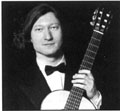Links on this page |
|
Midsummer Night Concert21.6.2003 |
||||
Mendelssohn: Overture a Midsummer Night's Dream Stephen Kenyon: Guitar Concerto no 1 (first performance) Schubert: Symphony no 5 |
Soloist - Fabio Zanon |  |
||
| Classical Guitar Magazine concert review | ||||
| Orchestra: The Oberon Chamber Orchestra led by Jack Maguire, Co-Principal, Bournemouth Symphony Orchestra | ||||
Saturday 21st June at 7.30 pm St Mary's Church, Edward Road Dorchester Tickets £10 (£4 students/school age) from 01305 257099 or on the door. |
For updates on the organisation and background to this concert please read the Countdown! Newsletter, which is available by email on request. |
January 2003
March 2003 |
||
|
June 1st 2003 |
||||
| Back to the top |
All photos: Nick Tredwell |
||
Here is the soloist, Fabio Zanon, fresh from a flight from Brazil! |
|
||
|
|||
Rehearsing the Concerto. |
|
||
The Tubular Bells play an important part in the slow movement... |
|
||
Rehearsing the Mendelssohn Overture. The large brass instrument near the camera is the Ophicleïde, played by Phil Humphries. |
|
||
| A study in concentration from the wind section... |
|
||
After the Overture. |
|
||
After the concerto. |
|
||
After the Schubert. |
|
||
Everyone needs a really good Tea Team! |
|
||
| Back to the top | |||
Here is the front of the programme. The programme note is shown below. |
|
||
Cover image: Titania and Bottom by J.H. Fuseli (detail) |
A Midsummer Night's Concert Fabio Zanon plays Stephen Kenyon's Guitar Concerto I St Mary's Church Dorchester Dorset 21 June 2003 |
Printed in Classical Guitar Magazine, October 2003, page 49. Written by Reviews Editor Tim Panting. |
||
I was invited to attend rehearsals for Stephen Kenyon's Guitar Concerto I and dutifully jumped at the chance. It is a double pleasure to attend rehearsals and a privilege, especially when it's a premiere and nerves are laid bare (and that's just from the person making the tea and cakes!) Kenyon (conducting), Zanon and the Oberon Chamber Orchestra, assembled at the church and worked through the programme of Mendelssohn's Overture to a Midsummer Night's Dream Op 21 plus the Nocturne from the Incidental Music to AMSND and Schubert's popular Symphony no 5. An interesting inclusion into the orchestra was an authentic Ophicleide, the instrument originally used for Bottom's character in the Mendelssohn. A 19th century bass-end of the bugle family later to be replaced by the tuba, it was to add an extra honk to Bottom's hee-haw. The rehearsal went well, and yes, nerves were laid bare but were soon soothed by the excellent refreshments. The concerto was written when Kenyon was still at college, he subsequently wrote two more but the first remained unperformed. Finding a virtuoso soloist is not the easiest of tasks and getting a show off the ground without the work being written by Rodrigo is a feat achieved by very few. Zanon had agreed to play the concerto but at the time his status in the world of professional music was not as great as it is now. Kenyon's ability to gather high-calibre musicians also grew over the intervening years and so when in 2001 with the idea for the concert blossoming and Zanon's renewed enthusiasm and advice from Music and Art Promotion Dorchester it was inevitable that the Concerto would at last be performed. An interesting note regarding he orchestra, fixing players and sponsoring, was the emergence of Player Sponsors. These generous souls helped boost the orchestra and in return, apart from the satisfaction of supporting the artistic cause, got reserved seating, signed programmes and access to the rehearsal. |
To the concert; the woodwinds ushered in the magic that is one of the most famous Overtures ever written. Kenyon rallied his band of merry men and women and roused the audience into a nicely intoxicated state of apprehension. Kenyon's concerto began with a solo declaration of around 20 barsfrom Zanon, a high ostinato pattern then followed whereby the orchestra introduced itself by way of the cellos. The music immediately felt accessible; the language veered from spicily tonal and grew more restless. The woodwinds, doubling piccolos were given lots of work and score got splashed with plenty of bright bolts of colour. The snare drum cranked up the tension towards the end of the first movement, which wound down to almost a whisper. The second movement had blissfully orchestrated parts with the language being in a different hue from the first. Its pastoral imagery had elements of Celtic music and perhaps Renaissance voicing, like magic mist, which built from very slow, with tubular bells, to a violent passage of arpeggiated chords from the soloist over which swooped an absolutely fiendish part for the duelling woodwinds. The final movement began with the snare drum and timpani to whip up more of a storm. There were poignant solos from the violin, with a piquant accompaniment from the guitar, and also from the oboe, which was particularly effective. The ending had the orchestra playing the penultimate chord followed by a cymbal then a lonely pizzicato note from the guitar, timpani and double bass, a tangible silence followed by rapturous applause. Zanon's playing throughout was full of vigour and depth. After the interval the Mendelssohn and Schubert wove their spell and Kenyon did a mightily impressive job conducting the orchestra. Stephen had the foresight to have the concert recorded, for purely non-commercial reasons and the atmosphere has been captured perfectly. It would be a shame if this concerto were not given another outing in the near future. Hopefully the forces that be can be persuaded. Tim Panting |
||